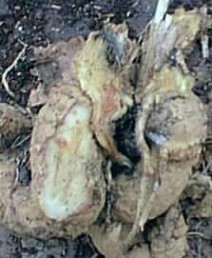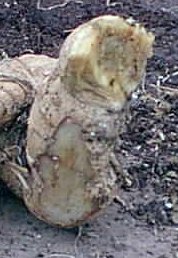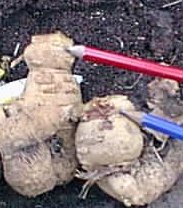Tubers
Dahlia Tuber Trouble Guide
Why haven’t my dahlias produced a tuber this season?
There are a number of reasons that plants have not produced tubers this season, primarily the problem has been due to high temperatures and lack of water. Dahlias require a huge amount of water in dry warm conditions, up to a gallon a day per plant. Coupled to this some varieties are notoriously bad tuber producers making small fibrous root systems with little storage root. The most problematic varieties are Hallmark, Impact and the Rhonda family although some of the giant flowered varieties are just as bad.
Tubers rotting in storage:
Generally these fall into 2 categories
1. The tuber that looks ok until you pick it up, then doesn’t feel right. ie. a bit soft and light in weight.
2. The tuber that is a black slimy mess once it has been removed from its packing, and then proceeds to stink the greenhouse out.
For both sets of symptoms the problem started prior to storage during the very soggy Autumn of last year, followed by some very hard frosts. Flooded Dahlia beds in October and cold weather later in November where the primary catalyst for our storage woes. Tubers when they where lifted where very wet and the plant stalks where full of water. These factors led to tubers that appeared to be dry and ready for storage but where still carrying excess water in the centre of the crown. under these conditions rot will thrive without being detected.
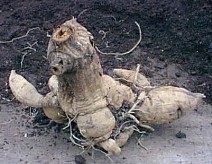
PICTURE: This tuber shows the signs of internal crown rot, the main stalk is soft and flaky to the touch and where the stalks have been cut back the centre of the stem is black.
By cutting the stem back to just above the crown it can be seen that the rot has spread right down inside the tuber.
By splitting the tuber down through the crown the rot can be seen as it spreads it’s way right through to the base of the tuber
Fortunately with some of these tubers it is possible to save them, it depends upon how far the rot has traveled toward the eye bearing part of the crown. By using a sharp knife eg a Stanley knife it is possible to perform surgery to remove the diseased part of the tuber and still get cuttings from it. Once the diseased tissue is removed a dusting of sulphur powder should suffice to prevent further rot.
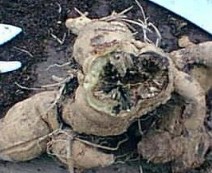
The image shows the tissue has been removed to prevent further rotting.
The remaining crown area where eyes will develop
Prevention of these problems is relatively simple, It will not prevent some losses but it will dramatically reduce the number of lost tubers due to them being waterlogged. Once the tubers are lifted and cleaned place them upside down on a dry greenhouse bench. once the surface has dried trim back the stems to about an inch above the crown. Then take a screwdriver and force it down the center of the stem until it pokes out of the base of the tuber. This will allow any excess water that is sitting in the center of the crown to drain out. leave for a couple of days to finish the drying process before treating with fungicide and storing as you would normally do so.
